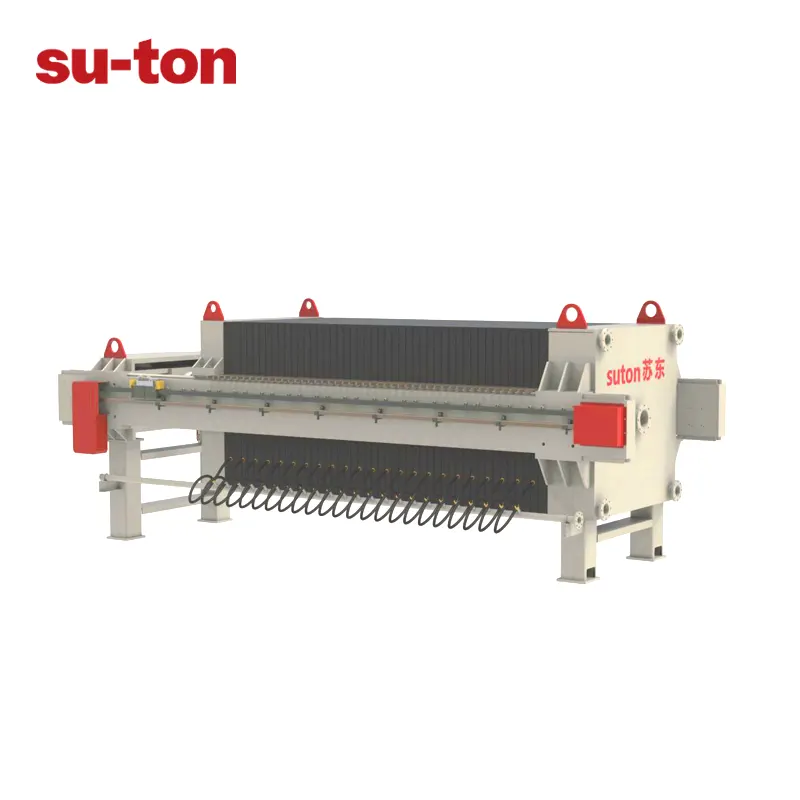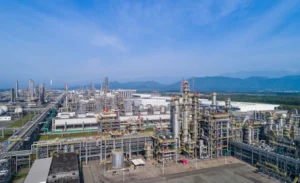Sludge Dewatering Filter Press
Sludge Filter PressFBXY composite rubber diaphragm filter plate is made of high-quality neoprene (DuPont/Chongqing Longevity), the sealing surface of the filter plate has elastic contact and good sealing performance; with the full rubber diaphragm plate pressing, the water content of the filter cake is low, the pressure of the diaphragm pressing can be up to 1.6MPa, with a large processing capacity, and the steel skeleton of the filter plate can be recycled many times with compound rubber and the comprehensive economic benefits are high.Adopting PLC programme control, high degree of automation, convenient operation and reliable performance; Engineering design, integrated control, energy-saving and high efficiency; - Adopting imported polymer TPE elastomer formula to produce high-pressure diaphragm filter plate, with pressing force up to 3MPa, through the second pressing of filtered sludge cake, it can reduce the water content of the cake to about 55%. Under the premise of economy, safety and environmental protection, the centralised disposal and resourceful use of sludge is achieved, realising the "reduction, harmlessness, stabilisation and resourcefulness" of sludge.
Sludge Dewatering Filter Press Working Principle
1,filter pressAfter the sludge conditioning is completed, the feed pump is started to inject sludge into the filter press. When the feed pressure reaches the preset feed pressure, the feed pump speed is adjusted through the frequency converter to reduce the feed pump flow to stabilise the feed pressure at the preset value, and the constant pressure feeding time is set according to the data during the installation and commissioning of the machine.
2、After the feeding is completed, the pressing pump starts to press the filter cake for the second time, when the pressing pressure reaches the preset pressing pressure, the speed of the pressing pump is adjusted through the frequency converter, and the flow rate of the pressing pump is reduced, so as to stabilise the pressing pressure at the preset value, and the pressing time is set up according to the data at the time of the installation and commissioning of the machine.
3、After the pressing is completed, the backblowing and reflux valves are opened, and the compressed air is used to blow the unformed materials in the feed hole of the filter press back to the conditioning tank. The time of blowing back is set according to the data when installing and debugging.
4、After the blowback is completed, the blowback and return valve is closed, the press return valve is opened, and the press water flows back to the press water tank. After the press water is emptied, loosen the pressing plate, the pulling plate system starts, and take the pulling plate to unload the material.
5、After unloading is completed, the pressure plate is pressed and the next cycle of work begins.
Start the sludge filter press water pump and gradually increase the pressure, and transfer the press water to each diaphragm filter plate chamber. The diaphragm filter plate is continuously expanded by the filling of press water, and the mud cake inside the filter chamber is affected by the expansion of the diaphragm filter plate, which accelerates the solid-liquid separation speed, and the water content of the mud cake is gradually reduced. When the press water pump pressurisation reaches 2.0MPa, the pressurisation is stopped and the pressure is maintained until the set time required by the process. The mud cake inside the filter chamber is forced to dewater by the full pressure of the diaphragm filter plate, which has reached the standard of process dewatering. Compressed air enters the centre hole to blow out the unpressed sludge from the centre hole.
The high pressure diaphragm press pump begins to stop and unload. The filter press can be unloaded. The hydraulic cylinder at the end of the machine base gradually unloads the pressure, the piston rod starts to move backward and pulls the push plate back to the initial position, the liquid-accepting flap opens automatically, and the filter plates are no longer in the closed and sealed state. The plate pulling robot is driven by the inverter motor to the first filter plate to take the plate, and when the plate is taken, the inverter motor starts to reverse and pulls the filter plate to the end of the push plate, and the filter cake falls off automatically under the action of gravity. Take the plate robot to repeat the above action, until all the filter cake on the filter plate clean, take the plate robot back to the initial position. Receiving liquid flap automatically closed unloading end, into the next link, automatic high-pressure cloth washing, automatic cloth washing frame driven by the motor to the gap in the middle of the two filter panels to stop and standby, take the board robot driven by the frequency converter inverter motor, will be the first piece of filter plate pulling to the cloth washing frame below the position of the stop, standby, washing rod downward movement at the same time to start the high-pressure cleaning of the filter cloth pumps, washing rod downward will be the residual sludge on the cloth with the water pressure of 8Ma Wash the cloth rack and pull the plate robot to repeat the above action, until all the filter plate cleaning once, wash the cloth rack and pull the plate robot to return to the initial position, the end of the cloth washing process, the filter press into the next work cycle.
Sludge Dewatering Filter Press Operating Procedures
1、Check the filter plate, filter frame and filter cloth for damage or folding before filter pressing, and lubricate the operating parts.
2, unloading slag should be carefully cleaned filter frame, slurry into the hole and filter plate, filtrate discharge hole.
3, automatic control system feedback signal device (such as proximity switches, electrical contacts, pressure gauges) must ensure the accuracy and reliability of the action, if there are problems should be repaired or replaced in a timely manner.
4. Keep the surface of the filter press clean to prevent rust and corrosion.
5, the maintenance of the hydraulic system is mainly to check the quality and quantity of hydraulic oil, hydraulic components and the sealing of the connection port check.
6, the filter plate filter frame on the frame is arranged in the order: from the thrust plate - filter frame - filter plate - filter frame - compression plate.
7、After the filter plate and frame are lined up on the frame, start the motor and play the manual reversing valve to the pressure position.
8、When the specified pressure is reached, it will automatically stop and keep the pressure, and the motor of the hydraulic station will stop, and it will enter into the state of pressure preservation.
9、After entering the pressure holding state, check the opening and closing state of each pipeline, after confirming that there is no error, start the feed pump and open the feed valve slowly.
10. Loosen the filter plate to unload the filter cake. Firstly, start the oil pump, firstly, put the manual reversing valve in the pressure position, loosen the locking nut and then put the manual reversing valve in the middle position, pause for a few seconds, then put the manual reversing valve in the return position. Stop the pump when the pressure plate is returned.
11. After the compression plate is withdrawn, pull the filter plates (frames) apart one by one, and at the same time unload the filter cake, clear the filter cloth, clean the filter plate, and keep the sealing surface of the filter plate clean.
Sludge Dewatering Filter Press Industry Applications
1、Chemical industry: dyestuffs, pigments, caustic soda, chlorine muted monitor mud, silica, saponin, graphite, bleaching powder, Lide powder, phosphor, insurance powder, chloric acid powder, copper sulphate, manganese sulphate, ferrous sulphate, ferric hydroxide, water purifying agent (aluminium sulphate, polymerized aluminium chloride, alkaline aluminium chloride) and so on.
2. Pharmaceuticals: antibiotics (aureomycin, erythromycin, spiramycin, wellbutrin, madicin, tetracycline, safranin, hygromycin), calcium phytate, traditional Chinese medicines, myo-inositol, growth derivatives of yarns, organophosphorus, saccharomyces cerevisiae and so on.
3、Foodstuffs: yellow wine, white wine, fruit juice, beverage, beer, yeast, citric acid, vegetable protein, vegetable molassesin, glucose, maltose, starch sugar, starch, rice flour, corn syrup, gum, carrageenan, monosodium glutamate (MSG), spices, sauce liquid, oral liquid, soya milk and seaweed, anaconda tablets, benadryl tablet and so on.
4、Metallurgy: gold ore, silver ore, copper ore, iron ore, zinc ore, rare earth and other powder beneficiation.
5、Oil refining: white oil, fragrance oil, light oil, glycerin, mechanical oil, vegetable oil, etc.
6, clay: kaolin, bentonite, activated clay, porcelain clay, electronic ceramic clay, etc..
7, sewage treatment: chemical sewage, smelting sewage, electroplating sewage, electrolytic sewage, leather sewage, printing and dyeing sewage, brewing sewage, pharmaceutical sewage, environmental sewage, paper sewage.
8、Mine: Coal processing industry, coal processing, tailing coal treatment, coking coal and so on.
Technical parameters
| FBXY 200-560/1500 400-1200/1800 Main performance/technical parameters: |
| Working filtration pressure | 0.4-0.6MPa |
| Maximum filtration pressure | 22MPa |
| Filter plate acid and alkali resistance | 2<PH<12 |
| Temperature resistance of filter plate | 0-100°C |
| Cake thickness | 32-35mm |
| valid itinerary | 1200mm |
| Diaphragm Pressure | 8-18MPa (subject to no material spray) |
| Area/Filter Plate | filter plate | capacity | power (output) | weights |
| mm | lump (of earth) | m³ | kw | kg |
| FBXY 200/1500 | 51 | 3.8 | 8 | 24300 |
| FBXY 220/1500 | 55 | 4.1 | 8 | 25660 |
| FBXY 250/1500 | 63 | 4.7 | 8 | 28250 |
| FBXY 280/1500 | 71 | 5.3 | 8 | 30920 |
| FBXY 300/1500 | 75 | 5.7 | 8 | 32100 |
| FBXY 320/1500 | 81 | 6 | 8 | 33950 |
| FBXY 340/1500 | 87 | 6.4 | 8 | 35860 |
| FBXY 400/1500 | 101 | 7.6 | 8 | 40400 |
| FBXY450/1500 | 115 | 8.5 | 8 | 45000 |
| FBXY500/1500 | 127 | 9.5 | 8 | 48860 |
| FBXY560/1500 | 143 | 10.6 | 8 | 54100 |
| FBXY 400/1800 | 69 | 7.6 | 8 | 47600 |
| FBXY 450/1800 | 77 | 8.5 | 8 | 51900 |
| FBXY 500/1800 | 87 | 9.5 | 8 | 57000 |
| FBXY 560/1800 | 97 | 10.6 | 8 | 62300 |
| FBXY 600/1800 | 103 | 11.4 | 8 | 64790 |
| FBXY 630/1800 | 109 | 11.9 | 8 | 67400 |
| FBXY 700/1800 | 121 | 13.3 | 8 | 73800 |
| FBXY 750/1800 | 129 | 14 | 8 | 77500 |
| FBXY 800/1800 | 139 | 15.2 | 8 | 82500 |
| FBXY 900/1800 | 157 | 17 | 8 | 93700 |
| FBXY 1000/1800 | 175 | 19 | 8 | 96000 |
| FBXY1100/1800 | 191 | 20.9 | 8 | 105800 |
| FBXY1200/1800 | 209 | 22.8 | 8 | 118600 |
| Remarks: | The final explanation of this product belongs to su-ton and is subject to change without prior notice.
|
| Sales Calls: | TEL:18118100011 |
To learn more about our products, please contact our engineers: 188-517-18-517 for your customised solutions.
Contact Us
Sales:181-181-000-11
Selection:188-517-18-517
Mailbox:suton@su-ton.com
 Plate and frame chamber diaphragm filter presses
Plate and frame chamber diaphragm filter presses




